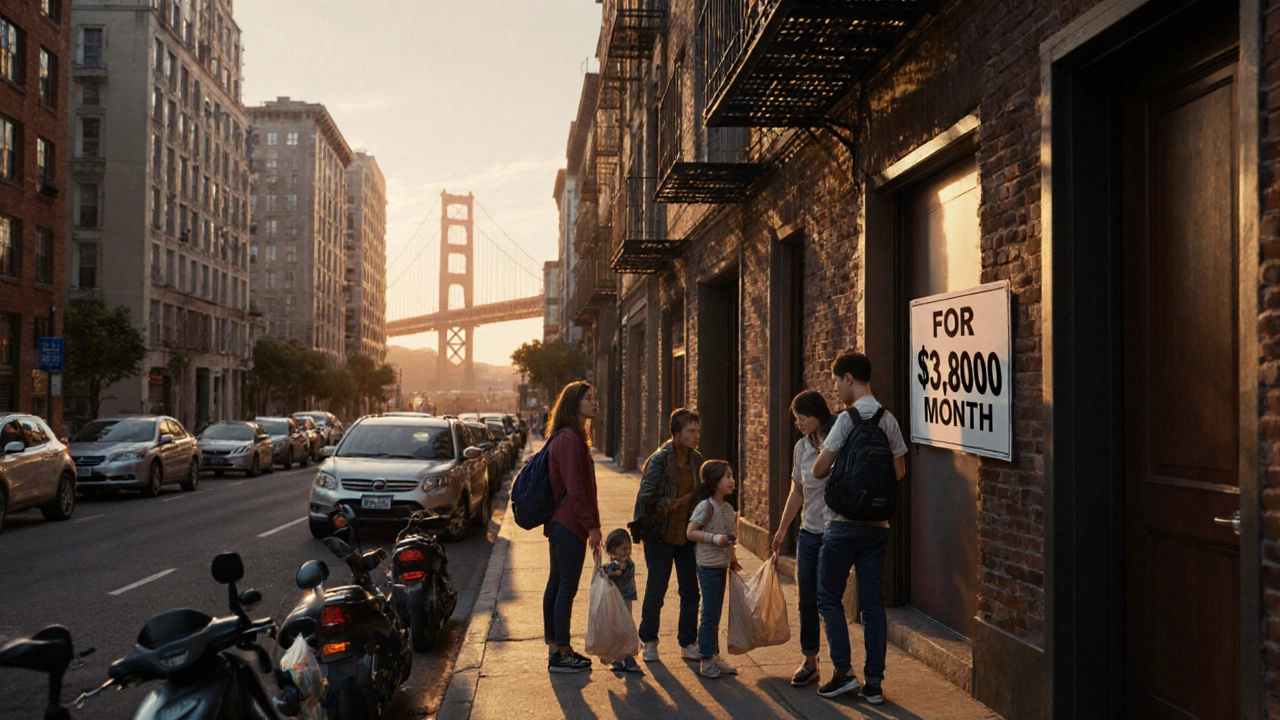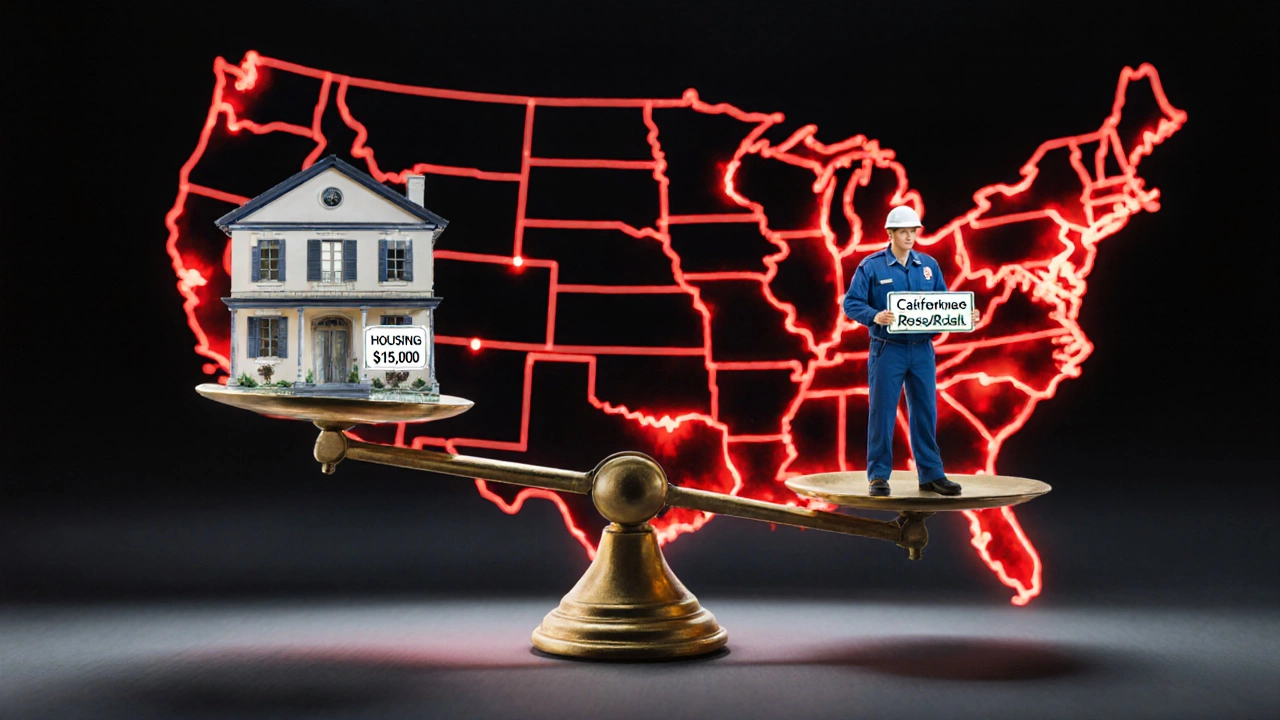What State Has the Worst Cost of Living? Top 5 Most Expensive States in 2025

Oct, 30 2025
Living Wage Calculator: Can You Afford to Live in an Expensive State?
If you’re trying to stretch your paycheck across rent, groceries, gas, and utilities, you’re not imagining things - some states are just harder to live in than others. In 2025, the gap between what you earn and what it costs to survive is wider than ever in a handful of places. This isn’t about luxury or tourism - it’s about whether you can keep a roof over your head, food on the table, and a car running without taking on debt. So which state has the worst cost of living? The answer isn’t just one place, but a pattern tied to housing, taxes, and wages.
Housing is the real killer
When people talk about cost of living, they’re usually talking about housing. And in 2025, housing costs are the biggest driver of financial stress in the U.S. The median home price in California is $845,000. In Hawaii, it’s $920,000. In Washington, D.C., it’s $710,000. These aren’t outliers - they’re the new normal. Rent isn’t much better. A one-bedroom apartment in San Francisco averages $3,800 a month. In New York City, it’s $3,600. In Boston, $3,200. That’s more than most people make in a month in states like Mississippi or West Virginia.
It’s not just big cities. Even smaller towns in these states are feeling the squeeze. In Portland, Oregon, rent has jumped 42% since 2020. In Austin, Texas, it’s up 58%. But Austin’s wages haven’t kept up. The result? People are living in their cars, commuting 90 minutes each way, or moving out entirely.
California: The state with the worst cost of living
California consistently ranks as the most expensive state to live in - and 2025 is no exception. According to the Council for Community and Economic Research, California’s cost of living is 51% higher than the national average. That’s not just housing. It’s groceries, electricity, car insurance, even bottled water. A gallon of milk costs $5.40 in Los Angeles. In Oklahoma City, it’s $3.10. A 12-pack of eggs? $6.85 in San Diego. $3.90 in Des Moines.
The problem isn’t just income. The median household income in California is $84,000. Sounds good - until you realize you need $115,000 just to cover basic needs in most parts of the state. That’s according to MIT’s Living Wage Calculator. A single adult with no kids needs $42,000 a year to survive. A family of four? $107,000. Most teachers, nurses, and retail workers don’t make that. So they work two jobs. Or live with six roommates. Or leave.
California also has the highest state income tax in the country - up to 13.3% for top earners. Add on sales tax (7.25% minimum, higher in many cities), property tax (even with Prop 13, it’s still steep), and mandatory health insurance fees, and you’re paying more just to exist.
Hawaii: The island trap
Hawaii has the second-highest cost of living in the U.S. - and the lowest median income among the top five. That’s a deadly combo. Everything you buy - from rice to toilet paper - has to be shipped across the Pacific. That adds 20-40% to the price. A pound of chicken? $8.50. A gallon of gas? $5.15. A new car? $45,000, even for a basic model.
Housing is worse. The median home price is $920,000. The average rent for a two-bedroom apartment is $3,900. The median household income? $85,000. That means half of all households are spending more than 50% of their income on rent alone - the federal standard for “housing burden” is 30%. In Maui, it’s common for teachers to work three jobs just to afford a studio apartment.
And there’s no escape. Moving out means leaving your job, your community, your kids’ school. So people stay - and struggle.

New York, New Jersey, and Washington: The Northeast and Pacific Northwest crunch
New York and New Jersey are tied for third in cost of living. In New York City, a one-bedroom apartment costs $3,600. In Hoboken, it’s $4,100. In Jersey City, $3,800. The state income tax in New York is up to 10.9%. In New Jersey, it’s 10.75%. Property taxes? The highest in the nation. In some towns, you pay more in property taxes than your mortgage.
Washington state is a surprise to many. Seattle’s median home price is $780,000. Rent for a two-bedroom? $3,100. But wages are lower than you’d expect. Tech workers make more, but retail, food service, and healthcare workers? They’re stuck. A nurse in Tacoma makes $75,000 - but needs $92,000 to live comfortably. That’s why homelessness has grown 22% in the Puget Sound region since 2020.
Even Oregon isn’t safe anymore. Portland’s rent is up 42% since 2020. The state has no sales tax - but that’s it. Everything else is rising. Gas is $4.90. Groceries are 18% above the national average.
Why these states are worse than others
It’s not just about being rich. States like Texas, Florida, and Tennessee have low taxes and cheaper housing - but they also have lower wages. The difference is that in those states, you don’t need a six-figure income to survive. In California, you do.
These high-cost states also have fewer affordable housing units. California has a shortage of 3.8 million homes. New York is short 1.2 million. Hawaii? 50,000 units. That’s not a temporary issue - it’s decades of zoning laws, NIMBYism, and underinvestment in public housing.
And wages haven’t kept up. The federal minimum wage hasn’t changed since 2009. Even states with higher minimums - like California’s $16/hour - still leave workers behind. At $16/hour, full-time work pays $33,280 a year. To afford a two-bedroom apartment in Los Angeles, you need $42,000. That’s 26% short.

Who gets left behind
It’s not just low-wage workers. Teachers, firefighters, nurses, and clerks are all being priced out. In San Francisco, a school teacher with 10 years of experience makes $78,000 - but pays $3,200 a month in rent. That’s $38,400 a year. After taxes, healthcare, and transportation, they’re left with $18,000 for food, utilities, and emergencies. No savings. No safety net.
Seniors on fixed incomes are hit hardest. In Hawaii, a retiree living on $30,000 a year spends 70% of it on housing. In California, it’s 60%. That leaves nothing for medicine, transportation, or emergencies.
And it’s driving migration. In 2024, over 120,000 people left California for Texas, Nevada, and Arizona. But even those states are getting pricier. The exodus is just pushing the problem elsewhere.
What can you do?
If you’re stuck in one of these states, here’s what actually works:
- Live farther out. In Los Angeles, moving 20 miles east to the Inland Empire can cut rent by 40%. But factor in gas and commute time.
- Get roommates. A two-bedroom split three ways cuts your housing cost by 60%. It’s not ideal, but it’s survivable.
- Use housing assistance. Section 8 vouchers, local rent subsidies, and nonprofit housing programs exist - but waitlists are years long. Apply anyway.
- Work remotely. If you can, move to a cheaper state while keeping your job. Many tech and corporate jobs now allow this.
- Track your spending. Use free apps like Mint or YNAB. Small cuts - coffee, subscriptions, dining out - add up to $500 a month.
There’s no magic fix. But awareness is the first step. If you’re paying more than 50% of your income on housing, you’re in crisis mode - not just budgeting.
States with the worst cost of living in 2025
| Rank | State | Cost of Living Index (U.S. Avg = 100) | Median Home Price | Median Rent (2BR) | Median Household Income |
|---|---|---|---|---|---|
| 1 | California | 151 | $845,000 | $3,500 | $84,000 |
| 2 | Hawaii | 149 | $920,000 | $3,900 | $85,000 |
| 3 | New York | 137 | $510,000 | $3,600 | $79,000 |
| 4 | New Jersey | 136 | $485,000 | $3,400 | $81,000 |
| 5 | Washington | 129 | $780,000 | $3,100 | $82,000 |
These numbers don’t lie. If you’re trying to build a life in one of these states, you’re playing on hard mode. The system isn’t broken - it’s designed this way. But knowing the facts helps you make smarter choices.
Which state has the worst cost of living in 2025?
California has the worst cost of living in 2025. Its cost of living index is 151 - 51% higher than the national average. Housing, groceries, taxes, and utilities are all significantly more expensive than in any other state. Even with a median income of $84,000, most residents need over $115,000 to cover basic needs.
Why is housing so expensive in California?
California has a shortage of 3.8 million homes. Decades of strict zoning laws, opposition to new construction, and slow approval processes have kept supply low. At the same time, demand keeps rising from people moving in for jobs, climate, or lifestyle. That imbalance drives prices up. Rent control laws also discourage landlords from building new units, making the shortage worse.
Can you live in California on minimum wage?
No. California’s minimum wage is $16/hour, which equals $33,280 a year for full-time work. To afford a one-bedroom apartment in most parts of the state, you need to earn at least $42,000. To afford a two-bedroom, you need over $50,000. That’s why many minimum wage workers live with multiple roommates, work multiple jobs, or rely on government aid.
Are there any affordable alternatives in California?
Yes - but with trade-offs. The Inland Empire (Riverside and San Bernardino counties) has rents 30-40% lower than Los Angeles or San Diego. But commutes are longer - often 90 minutes each way. Rural areas like the Central Valley are cheaper, but have fewer jobs, services, and public transit. You’re trading convenience for affordability.
Is moving to a cheaper state the best solution?
For many, yes. States like Texas, Tennessee, and Missouri have lower housing costs, no state income tax, and decent job markets. But moving isn’t easy - you lose your support network, your job may not transfer, and you may need to retrain. Still, for people struggling to pay rent or save for emergencies, the long-term financial relief often makes it worth it.